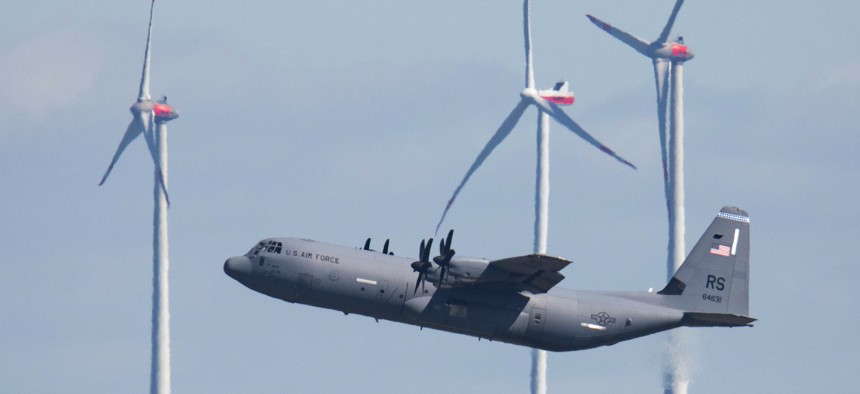
U.S. Air Force C-130J takes off from Ramstein Air Base in Rhineland-Palatinate, Germany, on May 13, 2022. Boris Roessler/picture alliance via Getty Images
The Air & Space Brief: ARRW takes flight; Moon mineral race; No word on Malmstrom UFOs; and more
Welcome to the Defense One Air and Space newsletter. Here are our top stories this week:
UFOs and warheads: A much-anticipated hearing on DOD’s new program to better understand unidentified aerial phenomena hit one of its more interesting points Tuesday when Rep. Mike Gallagher, R-Wisc., asked what DOD knew about a 1967 report of a glowing red orb over nuclear silo sites at Malmstrom AFB and subsequent reports that the encounter may have disabled as many as 10 nuclear warheads. Deputy director of naval intelligence Scott Bray, whose office has led DOD’s UFO work, replied, “We have not looked at that incident.” That flummoxed Gallagher: “But you’re the guys investigating, I mean, who else is doing it?” The alleged incident was described by four retired missileers (video) at a 2021 National Press Club event but has not yet merited a review by the Pentagon’s new UAP office.
The five-month-old office has received more than 400 reports of UAPs, which Bray and others told lawmakers indicates that there is no stigma in reporting a potential encounter.
ARRW takes flight: A Lockheed Martin-made missile flew five times the speed of sound, the U.S. Air Force announced Monday, bringing to three the number of U.S. hypersonic weapons that have achieved successful test flights. The AGM-183A Air-launched Rapid Response Weapon, or ARRW (pronounced: arrow) found success in its unpublicized Saturday test over the Pacific Ocean after failing in three earlier test flights.
Hermeus hypersonic transport: Aerospace and defense giant Raytheon Technologies is investing in Hermeus, the Georgia-based startup working to build hypersonic aircraft. It’s the first investment for RTX Ventures, the multibillion-dollar firm’s newly established venture capital group. Terms of the investment value were not disclosed; the funding is part of the Hermeus’ $100 million, Series B financing round.
Moon mineral race: More than bragging rights may be at stake in the U.S.-China race back to the Moon. Earth’s only natural satellite may be the “Persian Gulf of the solar system,” Bloomberg writes. “Unlike Earth, the moon may contain large amounts of helium-3, an isotope potentially useful as an alternative to uranium for nuclear [fusion] power plants because it’s not radioactive.” Two years ago, Chinese state media reported that experts believe that 5,000 tons of coal on Earth could be replaced by about three tablespoons of helium-3.
Sign up to get The Air & Space Brief every Tuesday from Tara Copp, Defense One’s Senior Pentagon Reporter. On May 17, 1974, NASA launched SMS-1, the first U.S. satellite “designed to monitor meteorological conditions from a geostationary orbit.”
 From Defense One
From Defense One
Another US Hypersonic Missile Hits Mach 5 in Test, Air Force Says // Marcus Weisgerber
Three different U.S. weapons have now demonstrated successful hypersonic flight.
Raytheon Technologies Invests in Hypersonic Aircraft Startup Hermeus // Marcus Weisgerber
It's the first investment by the aerospace and defense giant's new venture arm.




